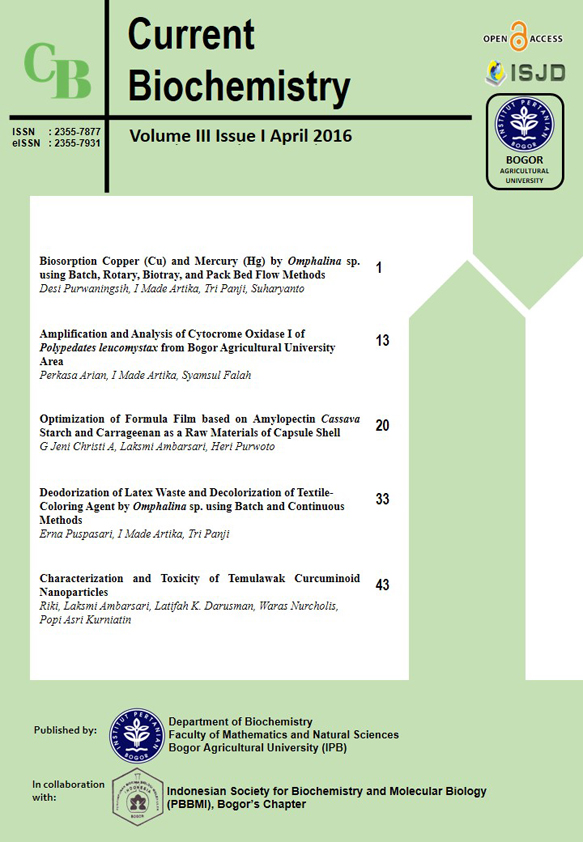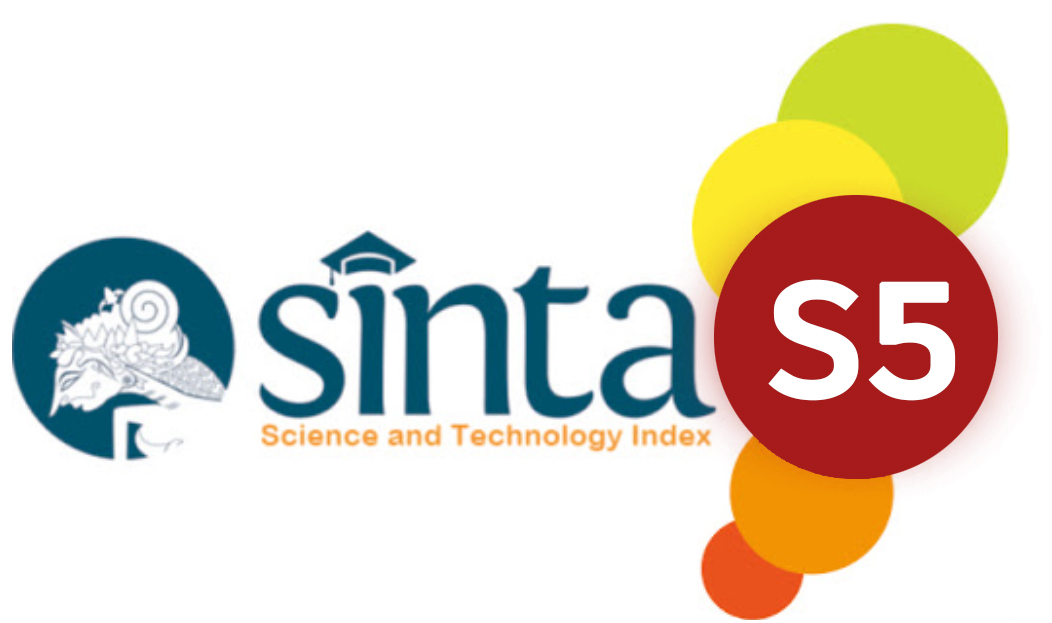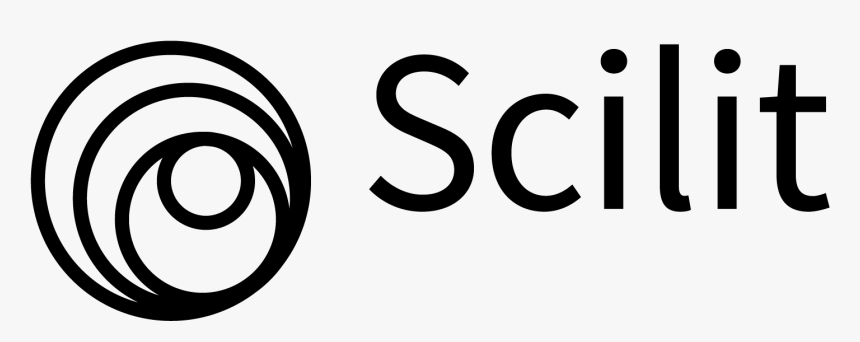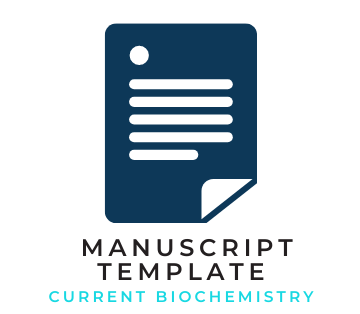Characterization and Toxicity of Temulawak Curcuminoid Nanoparticles
Abstract
Temulawak exctract contains curcuminoids which have anticancer potential. However, clinical application of curcuminoid has been limited due to its low bioavailability. One of the efforts that can be developed to solve this problem is incorporated curcuminoids into Solid Lipid Nanoparticles (SLN) carriers system. The objective of this study was to characterize dan evaluate anticancer potential of temulawak ethanolic fraction nanoparticles. HPLC method was used to determined curcuminoids content of temulawak ethanolic fraction. Characterization indicators like polydispersity index, particle size, morpholgy, and entrapment efficiency. HPLC chromatogram has shown of curcumin, demethoxycurcumin, and bisdemethoxycurcumin were found in temulawak ethanolic fraction. The particle size of nanoparticles obtained in this study was 648.4 ± 95 nm with polydispersity index value of 0.216. A uniform size distribution of nanoparticles as observed by Transmission Electron Microscopy (TEM). The entrapment efficiency of curcuminoid in nanoparticles was about 29.8%. Based on results of BSLT obtained temulawak extract Lethal Concentration (LC50) value of 213.24 ppm and 828.78 ppm of nanoparticles.
References
Alam G. 2002. Brine Shrimp Lethality Test (BSLT) sebagai bioassay dalam isolasi senyawa bioaktif dari bahan alam. Majalah Farmasi dan Farmakologi. 6(2):432-435.
Awad T, Helgason T, Kristbergsson K, Decker EA, Weiss J, McClements DJ. 2008. Solid lipid nanoparticles as delivery systems for bioactive food components. Food Biophysics. 3:146–154.
Banerjee M, Tripathi LM, Srivastava VM, Puri A, Shukla R. 2003. Modulation of inflammatory mediators by ibuprofen and curcumin treatment during chronic inflammation in rat. Immunopharmacol. Immunotoxicol. 25:213–224.
Bhardwaj V. and Kumar MNVR. 2006. Nanoparticle technology for drug delivery; Polymeric nanoparticles for oral drug delivery. Taylor and Francis Group. New York. E-book. http://ajprd.com/downloadebooks_pdf/49.pdf.
Basnet P and Basnet NS. 2012. Curcumin: A Challenge in cancer treatment-A review. JNPA.26(1):19-47.
Cahyono B, Huda MDK, Limantara L. 2011. Pengaruh proses pengeringan rimpang temulawak (Curcuma xanthorriza roxb) terhadap kandungan dan komposisi kurkuminoid. Reaktor. 13(3):165-171.
Carballo J, Hernandez-Inda ZL, Perez P, and Garcia-Gravalos MD, 2002. A comparison between two brine shrimp assays to detect in vitro cytotoxicity in marine natural products. BMC Biotechnology. 2(1): 17 pp.
Dewantari KT, Yuliani S, Yasni S. 2013. Ekstraksi dan karakterisasi nanopartikel ekstrak sirih merah (Piper crocatum). Jurnal Pasca Panen. 10(2):58-65.
Dhule SS, Penfornis P, Frazier T, Walker R, Fieldman J, Tan G, He J, Alb A, John V, Pochampally R. 2012. Kurkumin-loaded gamma(?)-cyclodextrin liposomal nanoparticles as delivery vehicles for osteosarcoma. Nanomedicine: Nanotechnology, Biology, and Medicine. 8:440-451.
Ekambaram P, Sathali AAH, Priyanka K. 2012. Solid lipid nanoparticles: A review. Sci. Revs. Chem. Commun. 2(1):80-102.
Ekaputra HR. 2013. Optimisasi dan karakterisasi nanokurkuminoid tersalut asam palmitat [Skripsi]. Bogor: Institut Pertanian Bogor.
Faraouq. 2003. Ekstrak sebagai salah satu pengembangan bentuk obat tradisional. Dalam: Prosiding Seminar Nasional Tumbuhan Obat Indonesia XXIII. Jakarta. Hal: 45-52.
Hwang, J.K. 2006. Xanthorrizol; A new bioactive natural compound. Departement of Biotechnology, Yonsei University, Yonsei.
Huda M. 2012. Pembuatan nanopartikel lipid padat untuk meningkatkan laju disolusi kurkumin [Skripsi]. Depok: Universitas Indonesia.
Jayaprakasha GK, Jaganmohan RL, Sakariah KK. 2002. Improved HPLC method for the determination of curcumin, demethoxycurcumin and bisdemethoxycurcumin. J Agric Food Chem. 50:3668–3672.
Jayaprakasha GK, Rao LJ, Sakariah KK. 2006. Antioxidant activities of curcumin, demethoxycurcumin and bisdemethoxycurcumin. Food chemistry. 98: 720-724.
Laitinen ML, Julkunen-Tiitto R, Tahvanainen J, Heinonen J, Rousi M. 2005. Variation in birch (Betula pendula) shoot secondary chemistry due to genotype, environment, and ontogeny. J. Chem. Ecol. 31:697717.
Lerdau, M. 2002. Benefits of the carbon-nutrient balance hypothesis. OIKOS 98:534-536.
Li Y, Gao J, Zhong Z, Hoi P, Lee SM, Wang Y. 2013. Bisdemethoxycurcumin suppresses MCF-7 cells proliferation by inducing ROS accumulation and modulating senescence-related pathways. Pharmacological Reports. 65:700-709.
Lim GP, Chu T, Yang F, Beech W, Frautschy SA, Cole GM. 2001. The curry spice curcumin reduces oxidative damage and amyloid pathology in an alzheimer transgenic mouse. J. Neurosci. 21:8370–7.
Luo Y, Chen D, Ren L, Zhao X, Qin J. 2006. Solid lipid nanoparticle for enhancing vinpocetine’s oral bioavibility. Journal of Controlled Release. 114:53-59.
Matsuda H, Tewtrakul S, Morikawa T, Nakamura A. 2004. Anti-allergic principles from thai zedoary: structural requirements of curcuminoids for inhibition of degranulation and effect on the release of TNF-a and IL-4 in RBL-2H3 cells. Bioorg. Medicinal Chem. 12:5891-5898.
Maulia P. 2014. Aktivitas antiinflamasi sediaan nanopartikel ekstrak kurkuminoid temulawak tersalut asam palmitat secara in vivo [Skripsi]. Bogor: Institut Pertanian Bogor.
Meyer UN, Ferigni NR, Putnam JE, Jacobsen LB, Nichols DE, and McLaughlin JL. 1982. Brine Shrimp: A convenient general bioassay for active plant constituents. Planta Medica. 45:31-34.
Mishra, P. 2009. Isolation, spectroscopic characterization and molecular modeling studies of mixture of Curcuma longa, ginger and seeds of fenugreek. IJPR. 1(1):79-95.
Mujib MA. 2011. Pencirian nanopartikel kurkuminoid tersalut lemak padat [tesis]. Bogor: Institut Pertanian Bogor.
Nurcholis W, Ambarsari L, Sari NLPE, Darusman LK. 2012. Curcuminoid contents, antioxidant and anti-inflammatory activities of Curcuma xanthorrhiza RoxB. and Curcuma domestica Val. promising lines from Sukabumi of Indonesia. Prosiding Seminar Nasional Kimia. Surabaya, 25 Pebruari 2012.
Parhi R, Suresh P. 2010. Production of solid lipid nanoparticles-drug loading and release mechenism. JCPR. 2:211–227.
Permasku G. 2014. Aktivitas inhibisi enzim a-glukosidase dan sitotoksisitas ekstrak kurkuminoid rimpang temulawak dari berbagai aksesi (in vitro) [skripsi]. Bogor: Institut Pertanian Bogor.
Piantino CB, Salvadori FA, Ayres PP, Kato RB, Srougi V, Leite KR, Srougi M. 2009. An Evaluation of the Anti-neoplastic Activity of Kurkumin in Prostate Cancer Cell Lines. International Braz J Urol. Vol. 35 (3): 354-361.
Pothitirat W and Gritsanapan W. 2005. Quantitative analysis of curcumin, demethoxycurcumin and bisdemethoxycurcumin in the crude curcuminoid extract from Curcuma longa in thailand by tlcdensitometry. MUJ Pharm Science.32(1-2): 23-30.
Shah R, Eldridge D, Palombo E, Harding I. 2014. Optimisation and stability assessment of solid lipid nanoparticles using particle size and zeta potential. Journal of Physical Science. 25(1):59–75.
Simanjuntak P, Rachman F, Logawa ED, Hegartika H. 2008. Aktivitas antioksidan ekstrak tunggal dan kombinasinya dari tanaman Curcuma spp. Jurnal Ilmu Kefarmasian Indonesia. 2(6):69-74.
Sonaje K, Italia JL, Sharma G, Bhardwaj V, Tikoo K, Kumar MN. 2007. Development of biodegradable nanoparticles for oral delivery of ellagic acid and evaluation of their antioxidant efficacy against cyclosporine A-induced nephrotoxicity in rats. Pharm Res. 24:899-908.
Sutrisno, Sukarianingsih D, Saiful M, Putrika A, Kusumaningtyas DI. 2008. Curcuminoids from Curcuma xanthorriza Roxb: Isolation, characterization, identification, and analysis of antioxidant activity. Proceedings of the first international symposium on temulawak. Bogor, 27–29 Mei 2008.
Tsuda Akira and Gehr Peter. 2015. Nanoparticles in the lung environmental exposure and drug delivery. CRC Press. Amerika Serikat. E-book.https://onlybooks.org/nanoparticles-in-the-lung-environmental-exposure-and-drug-delivery-18241.
Waghmare AS, Grampurohit ND, Gadhave MV, Gaikwad DD, Jadhav SL. 2012. Solid lipid nanoparticle: A promising drug delivery system. International Research Journal of Pharmacy. 4(3):100-107.
Wahid MBR. 2013. Aktivitas antioksidan nanokurkuminoid varietas temulawak asal balitro pada hati tikus jantan sprague dawley [Skripsi]. Bogor: Institut Pertanian Bogor.
Wijayanto EA. 2013. Kandungan kurkuminoid dan daya antioksidan aksesi temulawak (Curcuma xanthorrhiza roxb.) asal Sukabumi [Skripsi]. Bogor: Institut Pertanian Bogor.
Yadav V, Vinay P, Sarasija S, Yadav S. 2009. Kurkumin loaded palmitic acid microparticles. InPharm Communique. 1:15.
Yen FL, Wu TH, Lin LT, Cham TM, Lin CC. 2008. Nanoparticles formulation of Cucuta chijnensis prevents acetaminophen-induced hepatotoxicity in rats. Food and Chemical Toxicology. 46:1771–1777.













